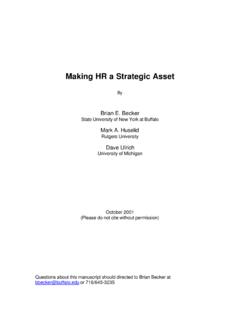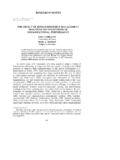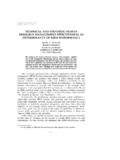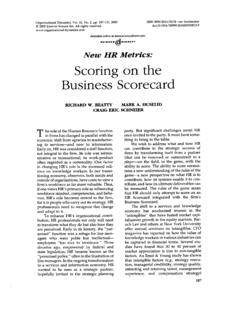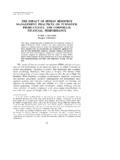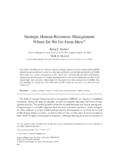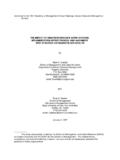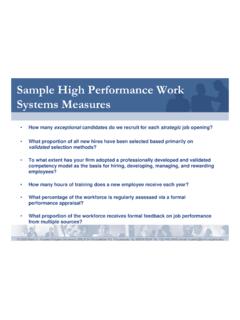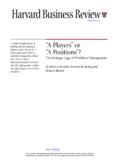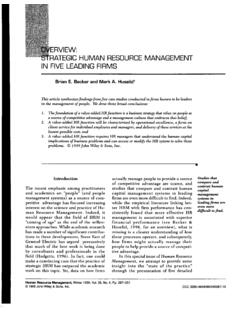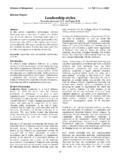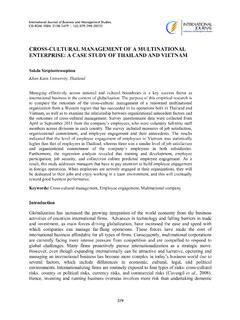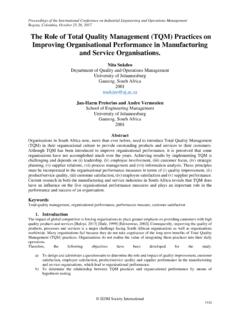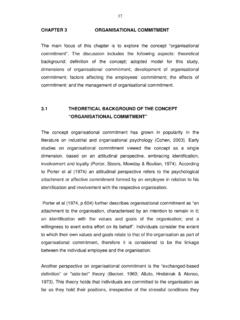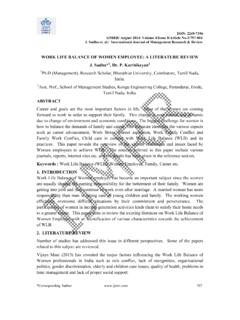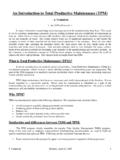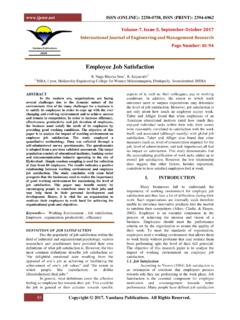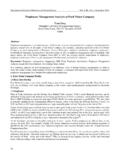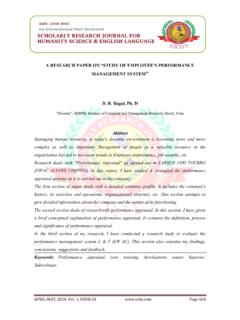Transcription of THE IMPACT OF HUMAN RESOURCE MANAGEMENT …
1 Academy of MANAGEMENT Journal1995, Vol. 38, No. 3, 635 IMPACT OF HUMAN RESOURCEMANAGEMENT PRACTICES ON TURNOVER,PRODUCTIVITY, AND CORPORATEFINANCIAL PERFORMANCEMARK A. HUSELIDR utgers UniversityThis study comprehensively evaluated the links between systems ofHigh Performance Work Practices and firm performance. Resultsbased on a national sample of nearly one thousand firms indicate thatthese practices have an economically and statistically significant im-pact on both intermediate employee outcomes (turnover and produc-tivity) and short- and long-term measures of corporate financial per-formance. Support for predictions that the IMPACT of High Perfor-mance Work Practices on firm performance is in part contingent ontheir interrelationships and links with competitive strategy was IMPACT of HUMAN RESOURCE MANAGEMENT (HRM) policies and prac-tices on firm performance is an important topic in the fields of HUMAN re-source MANAGEMENT , industrial relations, and industrial and organiza-tional psychology (Boudreau, 1991; Jones & Wright, 1992; Kleiner, 1990).
2 An increasing body of work contains the argument that the use of High Per-formance Work Practices, including comprehensive employee recruitmentand selection procedures, incentive compensation and performance man-agement systems, and extensive employee involvement and training, canimprove the knowledge, skills, and abilities of a firm s current and po-tential employees, increase their motivation, reduce shirking, and en-hance retention of quality employees while encouraging nonperformers toleave the firm (Jones & Wright, 1992; Department of Labor, 1993).I am very grateful to Brian Becker for his many helpful comments on this article and forhis direction and guidance on the dissertation on which it is based.
3 I would also like to thankJames Begin, Peter Cappelli, James Chelius, John Delaney, Steve Director, Jeffrey Keefe, Mor-ris Kleiner, Douglas Kruse, Casey Ichniowski, David Levine, George Milkovich, Barbara Rau,Frank Schmidt, Randall Schuler, Anne Tsui, David Ulrich, seminar participants at CornellUniversity and the University of Kansas, and this journal s anonymous referees for their com-ments on earlier versions. Any and all remaining errors are study was partially funded by grants from the HUMAN RESOURCE Planning Society,the Society for HUMAN RESOURCE MANAGEMENT Foundation, the Mark Diamond ResearchFund, and the SUNY-Buffalo School of MANAGEMENT . The interpretations, conclusions, andrecommendations, however, are mine and do not necessarily represent the positions of of MANAGEMENT JournalJuneArguments made in related research are that a firm s current and po-tential HUMAN resources are important considerations in the developmentand execution of its strategic business plan.
4 This literature, although large-ly conceptual, concludes that HUMAN RESOURCE MANAGEMENT practices canhelp to create a source of sustained competitive advantage, especiallywhen they are aligned with a firm s competitive strategy (Begin, 1991; But-ler, Ferris, & Napier, 1991; Cappelli& Singh, 1992; Jackson& Schuler, 1995;Porter, 1985; Schuler, 1992; Wright & McMahan, 1992).In both this largely theoretical literature and the emerging conven-tional wisdom among HUMAN RESOURCE professionals there is a growing con-sensus that organizational HUMAN RESOURCE policies can, if properly con-figured, provide a direct and economically significant contribution to firmperformance. The presumption is that more effective systems of HRMpractices, which simultaneously exploit the potential for complementar-ities or synergies among such practices and help to implement a firm scompetitive strategy, are sources of sustained competitive advantage.
5 Un-fortunately, very little empirical evidence supports such a belief. What em-pirical work does exist has largely focused on individual HRM practicesto the exclusion of overall HRM study departs from the previous HUMAN resources literature inthree ways. First, the level of analysis used to estimate the firm-level im-pact of HRM practices is the system, and the perspective is strategic ratherthan functional. This approach is supported by the development and val-idation of an instrument that reflects the system of High PerformanceWork Practices adopted by each firm studied. Second, the analytical fo-cus is comprehensive. The dependent variables include both intermedi-ate employment outcomes and firm-level measures of financial perfor-mance, and the results are based on a national sample of firms drawn froma wide range of industries.
6 Moreover, the analyses explicitly address twomethodological problems confronting survey-based research on this top-ic: the potential for simultaneity, or reverse causality, between High Per-formance Work Practices and firm performance and survey response , this study also provides one of the first tests of the prediction thatthe IMPACT of High Performance Work Practices on firm performance iscontingent on both the degree of complementarity, or internal fit, amongthese practices and the degree of alignment, or external fit, between a firm ssystem of such practices and its competitive BACKGROUNDThe belief that individual employee performance has implications forfirm-level outcomes has been prevalent among academics and practition-ers for many years.
7 Interest in this area has recently intensified, however,as scholars have begun to argue that, collectively, a firm s employees canalso provide a unique source of competitive advantage that is difficult forits competitors to replicate. For example, Wright and McMahan (1992),1995 Huselid637drawing on Barney s (1991) RESOURCE -based theory of the firm, contendedthat HUMAN resources can provide a source of sustained competitive ad-vantage when four basic requirements are met. First, they must add val-ue to the firm s production processes: levels of individual performancemust matter. Second, the skills the firm seeks must be rare. Since humanperformance is normally distributed, Wright and McMahan noted, all hu-man resources meet both of these criteria.
8 The third criterion is that thecombined HUMAN capital investments a firm s employees represent cannotbe easily imitated. Although HUMAN resources are not subject to the samedegree of imitability as equipment or facilities, investments in firm-spe-cific HUMAN capital can further decrease the probability of such imitationby qualitatively differentiating a firm s employees from those of its com-petitors. Finally, a firm s HUMAN resources must not be subject to re-placement by technological advances or other substitutes if they are to pro-vide a source of sustainable competitive advantage. Although labor-sav-ing technologies may limit the returns for some forms of investment inhuman capital, the continuing shift toward a service economy and the al-ready high levels of automation in many industries make such forms ofsubstitution increasingly less and McMahan s work points to the importance of HUMAN re-sources in the creation of firm-specific competitive advantage.
9 At issue,then, is whether, or how, firms can capitalize on this potential source ofprofitability. Bailey (1993) contended that HUMAN resources are frequent-ly underutilized because employees often perform below their maximumpotential and that organizational efforts to elicit discretionary effort fromemployees are likely to provide returns in excess of any relevant costs. Bai-ley argued that HRM practices can affect such discretionary effort throughtheir influence over employee skills and motivation and through organi-zational structures that provide employees with the ability to control howtheir roles are practices influence employee skills through the acquisition anddevelopment of a firm s HUMAN capital.
10 Recruiting procedures that providea large pool of qualified applicants, paired with a reliable and valid se-lection regimen, will have a substantial influence over the quality and typeof skills new employees possess. Providing formal and informal trainingexperiences, such as basic skills training, on-the-job experience, coaching,mentoring, and MANAGEMENT development, can further influence employ-ees effectiveness of even highly skilled employees will be limited ifthey are not motivated to perform, however, and HRM practices can affectemployee motivation by encouraging them to work both harder andsmarter. Examples of firm efforts to direct and motivate employee behav-ior include the use performance appraisals that assess individual or workgroup performance, linking these appraisals tightly with incentive com-pensation systems, the use of internal promotion systems that focus on em-ployee merit, and other forms of incentives intended to align the interests638 Academy of MANAGEMENT JournalJuneof employees with those of shareholders ( , ESOPS and profit- and gain-sharing plans).
